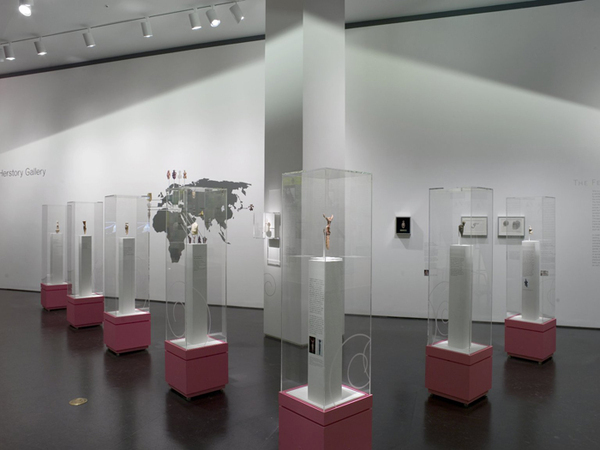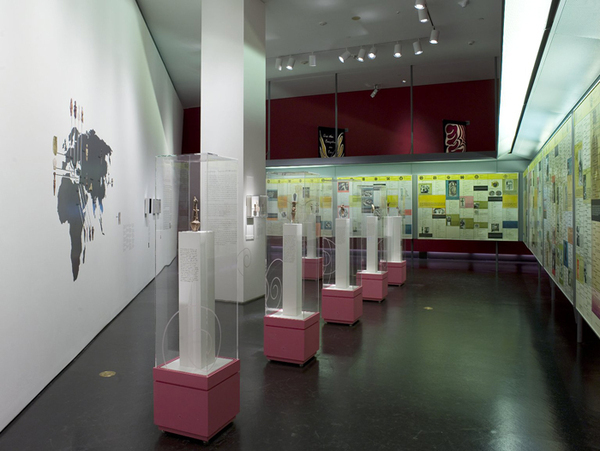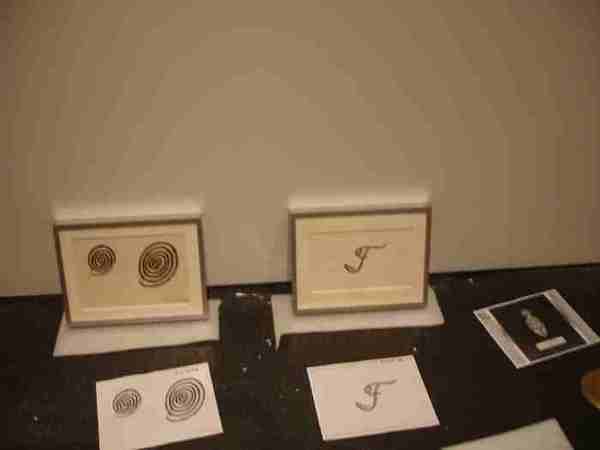The Fertile Goddess: Endings and Beginnings, Part I: Conception

An installation view of The Fertile Goddess in the Herstory Gallery. Photograph by Christine Gant.
As we deinstall The Fertile Goddess exhibition, it seems appropriate to reflect on a very good question that numerous visitors have asked me: how do we conceive of, plan, and create an exhibition like this one? So for those who did not get the chance to ask me this in person, here is the (long) answer in three parts.
I should mention here that the Herstory gallery exhibitions in the Center are slightly different from other special exhibitions in the Museum. First, the subjects for all these exhibitions are drawn directly from The Dinner Party, comprising the names of the guests and the related names on the Heritage floor, and second, while the planning phase is often shorter than normal, the shows usually remain on view for longer than the standard three month span of a special exhibition, which can affect the choice of objects, especially with regard to loans. Works in certain materials have restrictions on how long they can be exposed to light, for example, and requests for loans must often be made years in advance.

Another gorgeous photograph taken of the installation of The Fertile Goddess. From this angle you can also see the original didactic “murals” that Judy Chicago created for The Dinner Party. These are installed permanently in the gallery. Photograph by Christine Gant.
The Fertile Goddess began with a shared interest and an invitation. Before the Center opened, its staff undertook the monumental task of devising a web resource of background information about The Dinner Party. I was enlisted to assist with identifying and researching the ancient goddesses and women whose names appear on place settings or the heritage floor—a project that gave me an enormous amount of respect for all the research Judy Chicago did—truly amazing for the time! During this highly enjoyable collaboration, we began an ongoing dialogue on the subject of what is now known about ancient goddesses through scholarship and how feminist artists have drawn upon goddess imagery for their own work. As someone who always felt that contemporary art was “just not my millennium” and something I would just never “get,” this was a revelation for me, opening up a new realm of interest.
Then, in early 2008, Maura Reilly, the founding curator of the Center, contacted me to say that there was an opening in the exhibition schedule for the Herstory gallery and suggested that we collaborate on a “goddess” show. We chose The Fertile Goddess as our subject because, as the second guest in The Dinner Party, she is the first to be embodied in the form of small figurines sewn onto the place setting runner. (The first guest, The Primordial Goddess, is represented by spirals, fur and cowrie shells.) It was immediately clear to me that these figurines were inspired by ancient examples, giving us the perfect forum to illustrate the relationship between ancient art and contemporary feminist art that we had been discussing.
Drawings of letter studies for the Primordial and Fertile Goddess place settings await hanging. One of Judy Chicago’s contemporary goddess figurines was installed nearby. Photograph by Sarah Giovanniello.
I have always been interested in the fascinating—and frustrating—subject of ancient nude female figurines and the questions surrounding their identity and function. While researching and updating records for our ancient Middle Eastern objects as my current project for ECAMEA, I had been taking special note of such figurines, as well as other works that related to names from The Dinner Party. The “star” piece, of course, was our Halaf era figurine, which I discovered was the oldest sculpture in the Museum. Serendipitously, I found out that a friend and colleague I hadn’t seen in a while, Ellen Belcher, was working on Halaf figurines as a dissertation topic and had a lot to tell me about these and other ancient figurine types; she also agreed to serve as a volunteer consultant for the exhibition.
Stay tuned for more on this in the coming weeks, and for a different take on the use of this gallery, visit Patricia Cronin:Harriet Hosmer, Lost and Found, currently on view in the Herstory gallery through January 24, 2010.

Madeleine Cody is a Research Associate for Egyptian, Classical, and Ancient Middle Eastern Art. She has a B.A. in Classical and Near Eastern Archaeology from Bryn Mawr College, an MA in Egyptology from Brown University, and is currently completing her Ph.D. in Egyptian and Ancient Near Eastern Art and Archaeology at the Institute of Fine Arts, New York University. She has worked on excavations in Italy, Yemen and Egypt. Since coming to the Museum in 1997, she has been involved with numerous projects and assisted the late James F. Romano, Project Director, with the second phase of the reinstallation of the Egyptian Galleries, which opened in 2003. With Jim and Richard A. Fazzini, she is a co-author of Art for Eternity: Masterworks from Ancient Egypt (Brooklyn, 1999) and has written about other Egyptian objects from the Museum’s collection. Currently, she is working with the ancient Middle Eastern Art collection, her other area of expertise. She is co-curator of the Herstory Gallery exhibition, The Fertile Goddess, (December 19, 2008 – May 31, 2009).

